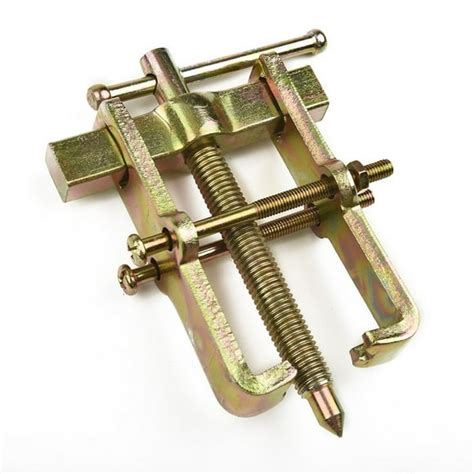Needle Bearing Puller: Your Essential Guide to Safe and Efficient Bearing Removal
Needle bearings are widely used in various industrial and automotive applications due to their ability to withstand high loads, reduce friction, and provide smooth operation. However, removing a needle bearing from its housing can be a challenging task without the right tools. A needle bearing puller is a specialized tool specifically designed to facilitate this process safely and efficiently.
What is a Needle Bearing Puller?
A needle bearing puller is a mechanical device used to extract needle bearings from their housings. It typically consists of a central arbor, a slide hammer, and a set of adapters or collets that fit around the bearing. The arbor is inserted into the bearing's inner race, while the slide hammer provides the force necessary to remove the bearing. The adapters ensure that the puller grips the bearing securely without damaging it.
Why Use a Needle Bearing Puller?
Using a needle bearing puller offers numerous benefits, including:

-
Safety: Using a puller reduces the risk of injuries compared to manual removal methods, as it eliminates the need for hammering or prying.
-
Efficiency: Pullers provide a controlled and efficient way to remove bearings, saving time and effort.
-
Precision: The adapters ensure that the puller engages with the bearing's inner race precisely, preventing damage to the bearing or housing.
-
Protection: Pullers protect the bearing and its components from damage during removal.
Types of Needle Bearing Pullers
There are different types of needle bearing pullers available, each designed for specific applications. The most common types include:

-
Slide Hammer Pullers: These pullers use a slide hammer to generate the force needed to remove the bearing. They are suitable for smaller bearings and can be used in various environments.
-
Hydraulic Pullers: Hydraulic pullers utilize hydraulic pressure to actuate the puller. They are more powerful and can be used for larger bearings.
-
Mechanical Pullers: Mechanical pullers use a lever or screw mechanism to generate the force necessary to remove the bearing. They are suitable for smaller bearings and can be used in confined spaces.
Choosing the Right Needle Bearing Puller
Selecting the appropriate needle bearing puller is crucial for safe and effective removal. Consider the following factors when making your choice:
-
Bearing Size: The puller's capacity should match the size of the bearing being removed.
-
Application: The type of puller will depend on the specific application, such as the size of the bearing and the accessibility of the work area.
-
Force Required: The puller should generate sufficient force to remove the bearing without causing damage.
-
Adaptability: The puller should include adapters that fit securely around the bearing's inner race to ensure proper engagement.
How to Use a Needle Bearing Puller
Using a needle bearing puller is a straightforward process that can be summarized in the following steps:
-
Identify Bearing Location: Locate the needle bearing within the housing.
-
Select Adapters: Choose the appropriate adapter size for the bearing's inner race.
-
Insert Arbor and Adapters: Insert the arbor into the bearing's inner race and secure the adapters around it.
-
Attach Slide Hammer: Attach the slide hammer to the puller's shaft.
-
Slide Hammer: Slide the hammer forcefully backward and forward to generate the necessary force to remove the bearing.
-
Repeat as Needed: Repeat steps 5 until the bearing is completely removed.
Precautions and Safety Tips
When using a needle bearing puller, follow these precautions for safety:
- Wear appropriate safety gear, including gloves and safety glasses.
- Inspect the puller before each use to ensure it is in good working condition.
- Ensure the bearing is securely engaged with the puller to prevent slippage and potential injury.
- Do not use excessive force that could damage the bearing or puller.
- If the bearing does not loosen after applying reasonable force, seek professional assistance.
Common Problems and Solutions
If you encounter problems while using a needle bearing puller, consider the following solutions:

| Problem |
Solution |
| Bearing is stuck |
Apply penetrating oil to the inner race and wait for it to penetrate |
| Puller slips |
Ensure the adapters are properly fitted and tightened |
| Bearing is damaged during removal |
Use a smaller adapter or reduce the force applied |
| Puller cannot generate enough force |
Try a different type of puller or increase the force applied |
Interesting Stories
Here are a few humorous stories related to needle bearing puller usage:
-
The Stuck Bearing: A technician was attempting to remove a stubborn needle bearing from a housing using a slide hammer. After numerous failed attempts, he realized the bearing was upside down.
Lesson learned: Always check the orientation of the bearing before using a puller.
-
The Broken Puller: A mechanic was using a mechanical puller to remove a needle bearing. However, the puller malfunctioned, and the bearing was launched across the room, narrowly missing the mechanic's head.
Lesson learned: Inspect the puller carefully before use and ensure it is in good condition.
-
The Wrong Adapter: A technician was using a puller with the wrong adapter size. As he applied force, the adapter slipped and damaged the bearing's inner race.
Lesson learned: Choose the correct adapter size and ensure it fits securely around the bearing's inner race.
Conclusion
A needle bearing puller is an indispensable tool for safely and efficiently removing needle bearings from their housings. By choosing the right puller for the application and following proper procedures, you can prevent damage to the bearing and ensure a smooth removal process. Remember to prioritize safety and seek professional assistance when encountering unexpected difficulties.

